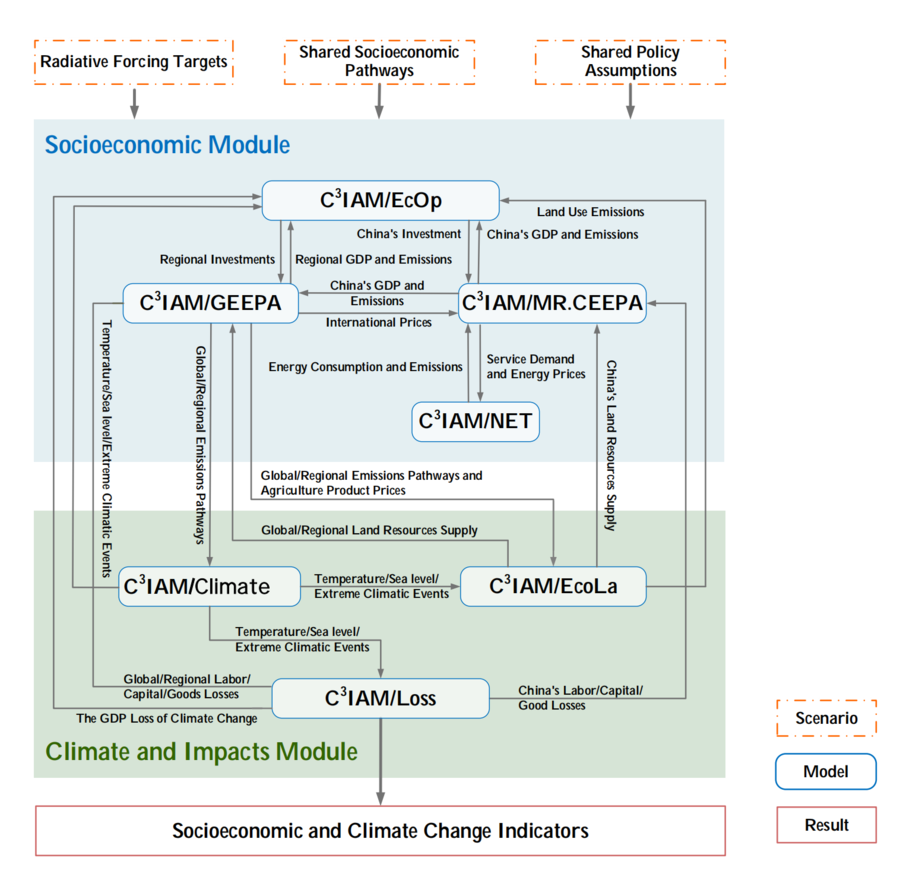Model scope and methods - C3IAM
| Corresponding documentation | |
|---|---|
| Previous versions | |
| Model information | |
| Model link | |
| Institution | Center for Energy and Environmental Policy Research, Beijing Institute of Technology (CEEP-BIT), China, http://ceep.bit.edu.cn/english/. |
| Solution concept | General equilibrium (closed economy) |
| Solution method | Optimization |
| Anticipation | |
C3IAM consists of various analytical models developed to analyze policy issues within a specific set of sectors as shown in Figure 1[1]. These models are interlinked to provide an integrated system for assessing the impact of climate change. C3IAM considers factors such as global multi-regional, multi-sectoral economic development, greenhouse gas emissions, emission reduction costs, climate change losses module, etc. It can not only depict the social economic system in detail, but also realize a long-term balanced growth path.
To apply C3IAM, all model settings are adjusted so that the model reproduces the state-of-the-world in 2011 and cover the period 2011–2100.
C3IAM pays more attention to clarify the comprehensive impacts of climate change and it has a better performance in the following various aspects:
1. More in-depth depiction of China: to refine the emissions pathway from the perspective of regional and sectoral, the Multi-Regional CGE Model (C3IAM/MR.CEEPA) that covers 31 provinces and the multi-sector technology model (C3IAM/NET) that covers eight energy-intensive industries are developed;
2. Extension of economic model: to capture the long-term optimal economic growth and climate change mitigation dynamically, C3IAM integrates the global CGE model (C3IAM/GEEPA) and the global economic optimum growth model (C3IAM/EcOp);
3. Realizing the hard link between the earth and socioeconomic systems: the economic models are integrated with earth system model, and the two-way feedbacks could be achieved.
<figure id="fig:The general structure of C3IA">
</figure>
References
- ↑ Yi-Ming Wei, Rong Han, Qiao-Mei Liang, Bi-Ying Yu, Yun-Fei Yao, Mei-Mei Xue, Kun Zhang, Li-Jing Liu, Juan Peng, Pu Yang, Zhi-Fu Mi, Yun-Fei Du, Ce Wang, Jun-Jie Chang, Qian-Ru Yang, Zili Yang, Xueli Shi, Wei Xie, Changyi Liu, Zhongyu Ma, Jinxiao Tan, Weizheng Wang, Bao-Jun Tang, Yun-Fei Cao, Mingquan Wang, Jin-Wei Wang, Jia-Ning Kang, Ke Wang, Hua Liao, 2018. An integrated assessment of INDCs under Shared Socioeconomic Pathways: an implementation of C3IAM. Natural Hazards 92, 585-618.
